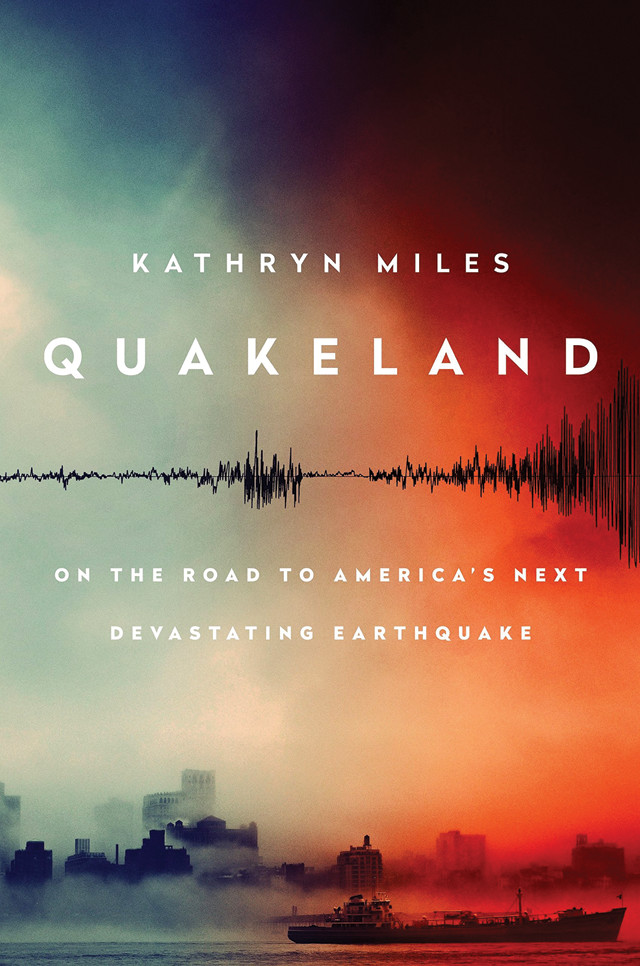
by Callan Bentley Tuesday, May 1, 2018

"Quakeland: On the Road to America's Next Devastating Earthquake" by Kathryn Miles, Dutton/Penguin Random House, 2017, ISBN 9780525955184.
by Callan Bentley
I was flying to Seattle when I finished Kathryn Miles’ 2017 book, “Quakeland: On the Road to America’s Next Devastating Earthquake.” I shut the book with a shudder of dread. There’s trouble brewing below the myriad coffee shops, not just in Seattle, but also across the Pacific Northwest. Seattle and the surrounding region sit atop the Cascadia Subduction Zone (CSZ), where the diminutive Juan de Fuca Plate dives eastward beneath the sizable North American Plate, producing a chain of stratovolcanoes arrayed along the coast like pearls on a string — an explosive geohazard.
What worries me more, though, is the multitude of faults that accommodate tectonic stress across the region. These faults, headlined by the subduction zone megathrust fault, are capable of slipping suddenly and releasing tremendous amounts of energy in the form of earthquakes — potentially some of the largest humans have ever seen. The 2011 magnitude-9 Tohoku earthquake occurred across the ocean in a very similar tectonic setting, and it was a seismological monster, unleashing violent shaking and a massive tsunami that inundated much of Japan’s coastline.
Preserved in the estuaries of Puget Sound, tsunami deposits from 1700 attest to the last time the Cascadia megathrust unleashed a major earthquake — estimated to have been about magnitude 9. Historical accounts of an anomalous tsunami in Japan unwittingly recorded evidence of this quake, so it’s known that the CSZ can send major tsunamis across the Pacific. Yet the fault hasn’t moved significantly in 300 years. And during that time, we’ve built several major metropolises above it — Seattle being the biggest.
I visited the city on a cold and rainy day (not a rarity there). It occurred to me that if I were unlucky enough to be in Seattle when a magnitude-9 earthquake struck, almost all the buildings would be uninhabitable and the city’s population would head outside into the cold rain — for days. It’s a grim thought, but just one of many that occupied mental real estate after I finished reading “Quakeland.”
Miles isn’t a seismologist, or even a geologist. Rather, she’s a journalist who has immersed herself in earthquakes with a passionate zeal. Sometimes, it takes a nonspecialist to sort out what is most worth reporting, and what will resonate most with the public. And in that light, “Quakeland” offers a current, useful compilation about earthquake hazards, science and related policy, albeit one that’s presented somewhat breathlessly and features a few too many errors for my comfort.
Miles has a distinctive voice, and overall, the book — structured like a road trip travelogue — has an informal feel. Miles recounts historical earthquakes in the United States and around the world: From Tohoku to L’Aquila to Mexico City, some of the examples she highlights remind us that the violence and danger of earthquakes are exacerbated by weak building codes and loose substrates (like those that underlie many parts of the Seattle area, for instance).
She dedicates chapters to earthquake prediction, which, as she rightly notes, is still beyond our abilities, as well as to earthquake early-warning systems. In the early-warning chapter, she includes a helpful review of best practices for preparing for and surviving an earthquake.
In the chapter on the relationship between hydraulic fracturing (“fracking”) and earthquakes, the causal connection between wastewater injection (which often accompanies fracking operations) and earthquake triggering should have been made more explicit at the outset. She eventually raises the distinction, but it’s an important issue that is often confused in the public discourse about fracking and deserves a clear and prominent discussion. Furthermore, Miles confuses the role of sand in this process: Sand grains act not as an “abrasive,” as she describes, but as tiny support structures to prop open newly fracked cracks in deeply buried rocks. Nonetheless, this is a useful chapter, as it explores the science of one of the more prominent applications of seismology in the minds of average citizens.
“Quakeland” would have benefitted from a thorough review of the science it describes before printing. There were numerous errors, some small — hot spots are described as “burning” and faults are called “fault lines” — while others were significant, such as Yellowstone and Hawaii being described as places where oceanic crust is destroyed. In some cases, mistakes were just sloppy: transposing south and north in describing Coeur d’Alene’s position relative to the University of Idaho, for instance, or failing to identify affiliations or credentials of a source quoted as an expert on geothermal energy. These things should have been caught by Miles’ editor.
Thankfully, the word “temblor” never appears in the book. For that, Kathryn Miles gets my eternal gratitude!
© 2008-2021. All rights reserved. Any copying, redistribution or retransmission of any of the contents of this service without the expressed written permission of the American Geosciences Institute is expressly prohibited. Click here for all copyright requests.